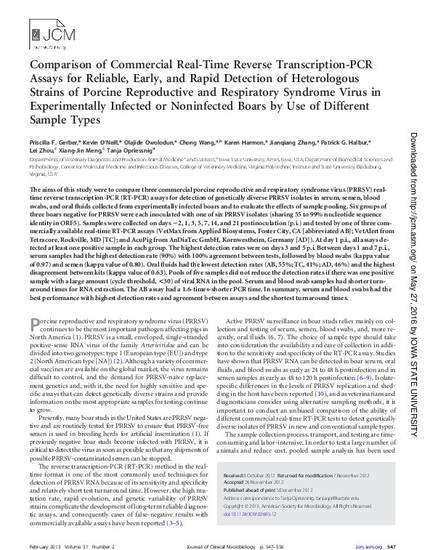
The aims of this study were to compare three commercial porcine reproductive and respiratory syndrome virus (PRRSV) real-time reverse transcription-PCR (RT-PCR) assays for detection of genetically diverse PRRSV isolates in serum, semen, blood swabs, and oral fluids collected from experimentally infected boars and to evaluate the effects of sample pooling. Six groups of three boars negative for PRRSV were each inoculated with one of six PRRSV isolates (sharing 55 to 99% nucleotide sequence identity in ORF5). Samples were collected on days −2, 1, 3, 5, 7, 14, and 21 postinoculation (p.i.) and tested by one of three commercially available real-time RT-PCR assays (VetMax from Applied Biosystems, Foster City, CA [abbreviated AB]; VetAlert from Tetracore, Rockville, MD [TC]; and AcuPig from AnDiaTec GmbH, Kornwestheim, Germany [AD]). At day 1 p.i., all assays detected at least one positive sample in each group. The highest detection rates were on days 3 and 5 p.i. Between days 1 and 7 p.i., serum samples had the highest detection rate (90%) with 100% agreement between tests, followed by blood swabs (kappa value of 0.97) and semen (kappa value of 0.80). Oral fluids had the lowest detection rates (AB, 55%; TC, 41%; AD, 46%) and the highest disagreement between kits (kappa value of 0.63). Pools of five samples did not reduce the detection rates if there was one positive sample with a large amount (cycle threshold, <30) of viral RNA in the pool. Serum and blood swab samples had shorter turnaround times for RNA extraction. The AB assay had a 1.6-times-shorter PCR time. In summary, serum and blood swabs had the best performance with highest detection rates and agreement between assays and the shortest turnaround times.
Available at: http://works.bepress.com/chong-wang/43/

This article is from Journal of Clinical Microbiology 51 (2013); 547, doi: 10.1128/JCM.02685-12. Posted with permission.